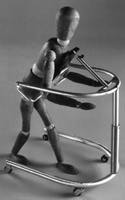1994 Project Reports | Contents | Previous | Next | Home |
Walking Assist Devices to Restore Ambulation
Eric E Sabelman, PhD; Charles G Burgar, MD; Maurice LeBlanc, MS; Douglas Schwandt, MS; Mordechy Zimmerman, MS; Robert Whalen, PhD; Gregory Breit, MS
Objectives - The goal is to develop several devices for patients who are graduating from a bed or a wheelchair but are not yet (or will never be) ready for ambulation using conventional walkers, crutches or canes. These devices are intended for a range of applications - from clinical use for support of patients' partial body weight through chronic use by frail elders living in the community. A major goal will be to ease transition among these devices and others including the bed and wheelchair as a user's capabilities improve or decline, by employing similar components and performance monitoring. The design of each device is intended to equal or improve upon the therapeutic value of water immersion, parallel bars and suspension devices, while providing more freedom of movement for the patient and less risk to the therapist at lower cost. The availability of an assistive device matched to the needs of the patient or chronic user may mean the difference between discouragement and success in rehabilitation. All too often the only available aids impose added burdens such as regression and relearning during each transition to a new device.
Approach - The approach employed in this project is to conduct need assessment studies, develop biomechanical models, generate concepts, fabricate small-scale and full-scale prototypes and conduct limited clinical trials of devices to improve the ability to walk. Device development will draw upon Rehab R&D Center experience with the Rehabilitation Walking Aid, developed as a student project in the Stanford University Mechanical Engineering Design Division, and the Differential Pressure Walking Assist joint project with NASA Ames Research Center as well as experience with alternative crutch design at Lucile Packard Children's Hospital's Rehabilitation Engineering Center at Stanford. In each case, functional prototypes have demonstrated concept feasibility, but also the need for design improvements before multi-center evaluation by large numbers of users having varied capabilities.
To generate a series of assistive walking devices appropriate to each phase of rehabilitation, several project phases have been planned:
- A Stanford University Mechanical Engineering Design Division (ME281) project to redesign the common crutch for reduced metabolic energy load is in progress. Other student projects related to walking aids for the chronically impaired are anticipated.
-
A scale model of the re-designed Rehabilitation Walking Aid (Figure 1) has
been constructed to demonstrate ergonomic compatibility with the human body.
The concept is based upon the patient's upper body leaning forward resting the
trunk and lower arms on padded supports. A safety harness is ready to support
the patient's weight if the knees buckle. As the patient progresses, the amount
of forward lean is reduced, until the patient is walking upright.

Figure 1. Scale model of the Rehabilitation Walking Aid. - The Differential Pressure Walking Assist, an inflatable conical structure around the lower body which reduces ground reaction forces and provides lateral support at the waist, will be re-designed to permit walking on a treadmill, or mobility on a smooth floor.
- A walking performance recording and display module, incorporating accelerometry from the Upper Body Motion Analysis to Ameliorate Falls in the Elderly project (see previous report), will be adapted for use with walking aids. Body accelerations, combined with loads and motions of the assistive device, yield information about walking speed, distribution of body weight, and relative body segment motion. This feedback can be used to determine the efficacy of a new walking assist, fine-tune designs, and to monitor an individual patient's progress.
- A clinical trial of the Rehabilitation Walking Assist will be conducted at the Palo Alto VA Clinical Rehabilitation Center's Ambulation Clinic and Spinal Cord Injury Center.
Republished from the 1994 Rehabilitation R&D Center Progress Report. For
current information about this project, contact
Eric Sabelman.
